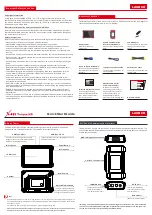
HypnoSquare Instructions v 1.3, May 2009
- 5 -
Step 4: Small capacitors
Next solder the 5 small 0.1uf ceramic capacitors, shown in
the board in spots C4, C5, C6, C7, and C8. These are the decoupling
caps for each IC.
These ceramic capacitors are not orientation dependent - either wire can
go in either hole.
Figure 7: Ceramic capacitors in place.
Step 5: Chips, dips, chains, whips...
It's time to place some chips. When the chips are down....
ICs can be damaged by static from your fingers, so ground yourself as usual when working with static-sensitive
electronics.
The chips can be difficult to fit since their pins are usually splayed out a bit. It might help to bend the pins
slightly before inserting. I used a book and the table to provide a straight, flat right-angle surface to bend them
all slightly and at once.
We will start with the 4 SN74AHC574N chips (
Be sure to orient the chips properly! There is a notch on one end of the
chip (left side on
Figure 8
,) and this should align with a notch drawn
on the PCB footprint.
It can be helpful to tack the chip by soldering just 2 corner pins in
place, and making sure that the chip is properly seated before soldering
the rest. Uneven seating won't harm anything, but may not look very
good either. It's also good to double-check that the chip is oriented
properly - you really don't want to be trying to extract one after it's all
soldered in.
Figure 6: 0.1uF ceramic capacitor.
Figure 8: SN74AHC574N






































